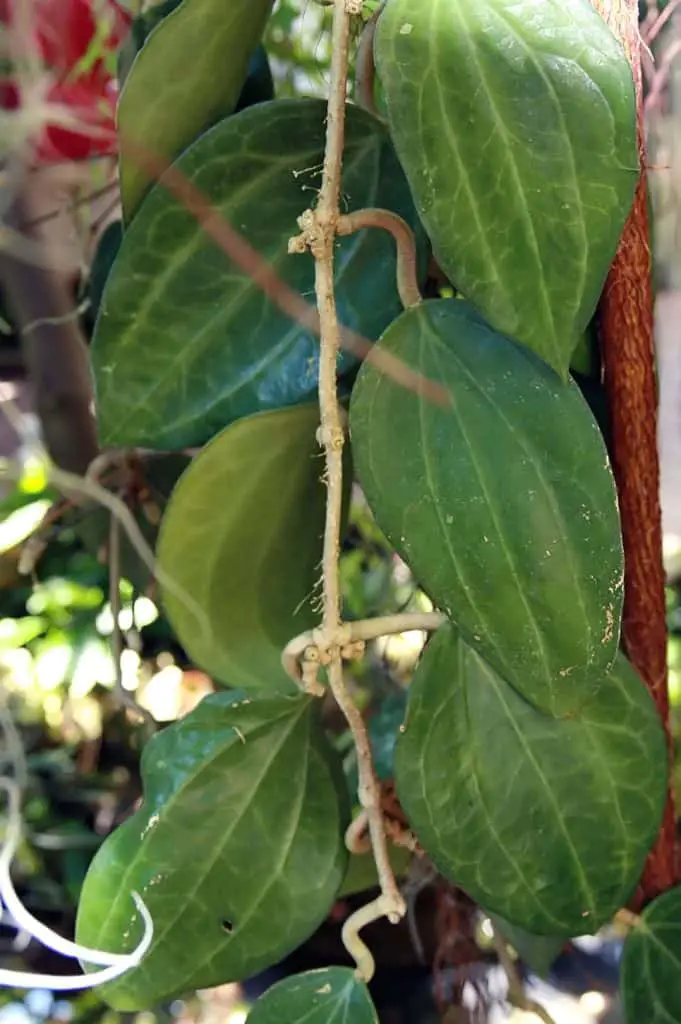Hoya Latifolia, also known as wax plant or dinner plate plant, is an interesting plant with a vine-like structure of stems, waxy leaves, and light-colored flowers that bloom like fireworks. Hoya Latifolia is an endangered plant native to Singapore, and most coveted for its unique shape, pretty blooms, and its huge, round leaves, which earn the plant the nickname “dinner plate plant.”
Under the right conditions, Hoyas can grow quite fast! But it is normally considered a slow growing plant because it is particular about its temperature. Latifolia must be warm, or else they simply will not grow. While Hoya Latifolia is not too challenging to grow, it is definitely more for intermediate planters.
Hoya Latifolia Care
Plant your Hoya Latifolia in a big pot with ample drainage. They are also climbing plants, so investing in some plant stakes, or even considering a tiered planter might be worth your while.
It is best to use soil that has pebbles for drainage, and good air circulation. This species of Hoya tend to enjoy similar mixes to orchids, so using a soil marketed for orchids is a good choice. In addition, use fertilizer for orchids to fertilize the plant once a month. Ensure the soil pH is in the range of 6 to 7 for Hoya Latifolia. They tend to like their soil acidic but can also tolerate a slightly alkaline mix.
Hoya Latifolia has a hardiness zone of 11, but can also survive in zone 10 as long as it is kept above 70 degrees. Beware of this if you plan to take your Hoya outdoors.
The best place for your dinner plant is going to be in a bright window that only gets about 2-3 hours of direct sun. Hoyas enjoy sunlight, but they also like their shade, and should not receive an abundance of direct sunlight; too much of it will burn the leaves and turn them yellow. Choose a bright space, that still provides an acceptable amount of shelter from the sun’s rays. It is important to note that Hoyas can compromise on their light, as they’ve been proven to survive in lowlight conditions just fine.
What they will not compromise on is their temperature. For the most optimal growth, ensure Hoya Latifolia is never kept in conditions below 70 degrees Fahrenheit. Hoya Latifolia will also be happy in 85-degree weather and has been known to survive 90-degree heat. For the best temperature, I’d suggest trying to maintain about 80 degrees, year-round. Keeping humidity levels around 60% and over can also help your dinner plant thrive.

Water your Hoya when its soil is nearly dry. Hoyas do not like soggy soil, so be wary of overwatering. It’s probably best to stick to watering your Hoya once a week to make sure it doesn’t get waterlogged. Note that the colder the temperature the plant is in, the less it is going to grow, and therefore, the less water it is going to need.
Hoya Latifolia Flower
When all the conditions above are met, Hoya Latifolia have no problem flowering. If you wish to help the plant along, fertilizing it with some diluted orchid fertilizer during the growing months will do a great deal. In addition, ensure the soil is not too wet before watering.
There can be hundreds of little flowers on one single bloom! Not to mention, hoyas are often kept around for their aromatic properties. They are wonderful at purifying the air and adding their own scent of sweetness.
Hoyas are not toxic to humans or animals. Now, that doesn’t mean you should go eating your beautiful Hoya, despite one of its nicknames being “dinner plate plant.” But even so, it’s reassuring to know that if pets or little ones get a hold of a leaf or two, they’ll be alright.
Problems Growing Hoya Latifolia
- Dropping leaves; if your plant is dropping leaves, then it is upset with your watering system. Most often, overwatering is the cause of dropping leaves.
- Leaves turning red; Leaves turning red can indicate too much direct sunlight, however, they are also a sign of over-fertilization. Be sure to only fertilize the hoya with half diluted fertilizer, once a month, during its growing season.
- Bugs; Hoya plants in particular are susceptible to a lot of pests, due to their succulent-like texture. If you see bugs on your hoya, spray them off with water, then treat the leaves with neem oil.
Propagating Hoya Latifolia
There are three main ways to propagate or grow Hoya Latifolia.
Propagating in Water
Take a standard cutting of Hoya with one node and at least one leaf, and place the cutting in a cup of water so that the node is submerged. Change water when it gets murky or dirty, and be wary of cold water from the tap, as that will shock the plant. Room temperature or slightly warm water is most desirable.
Propagating by Planting Cuttings in Soil
Take a standard cutting, soak the node in rooting hormone, then plant in a pot of good soil.
Propagating by Sowing Seeds in Soil
Hoyas can be grown from seed. Sow the seeds in semi dry soil, and allow them to germinate and grow within the course of a year. Keep the seeds watered but not too damp.
Note: Most gardeners prefer the cutting method (#1 & #2), as certain species of hoya plant seeds can be harder to come by, and grow. The cutting method also tends to root much faster.
Hoya Latifolia Varieties
Hoya plants have many different nicknames and variations of themselves. So in case you’re wanting more insight, here’s a quick guide on what to look out for.
Hoya Latifolia Albomarginata
Hoya Latifolia Albomarginata is a rare hoya that has wider leaves with more distinct creases, and a less round shape. Known for variegated leaves that range from pink, to green, to white.
Hoya Latifolia Dinner Plate
Hoya Latifolia Dinner Plate is a hoya with huge leaves so big and round they look like plates you could eat off of!
Hoya Latifolia Snow Queen
Hoya Latifolia Snow Queen has leaves that look like they’ve been splattered with a bit of cream paint, or snow.
Hoya Latifolia Baibua
Hoya Latifolia Baibua has pointier leaves that look like lotus petals.
Hoya Latifolia Pot of Gold
Hoya Latifolia Pot of Gold has leaves with a distinct golden streak going down their center. This is not to be confused with a bleached or browning leaf that is unhealthy. The golden streak looks beautiful and deliberate.
Hoya Latifolia Big Leaf
Hoya Latifolia Big Leaf, also known as Big Leaf Hoyas, are a category of hoyas named for, well, their huge leaves! Dinner plate hoyas make this category. Some other common big leaf hoyas are Hoya Lauterbachii, Hoya Sarawak, Hoya Clandestina, Hoya Joya, Hoya Skinneriana, and Hoya Latifolia of course!
Hoya Latifolia Sarawak
Hoya Latifolia Sarawak were sourced from Sarawak. They are often marked by their adorable pink flowers.
Hoya Latifolia Pink
Hoya Latifolia Pink refers to when a certain variation of hoya plant bares fuzzy, pink flowers. This trait can be found in many hoyas and is hard to pinpoint per plant.
Hoya Latifolia Splash
Hoya Latifolia Splash, or Splashed Hoyas, are hoyas like the snow queen; the green leaves look like they have been splattered with a lighter color. Almost like plant freckles! Some beautiful, splashed Hoyas are Hoya Gelatis, Hoya Cartesia, Hoya Heartleaf, and Hoya Croniana Silver, to name a few.
